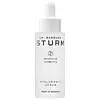What's inside
What's inside
 Key Ingredients
Key Ingredients

 Benefits
Benefits

 Ingredients Side-by-side
Ingredients Side-by-side

Water
Skin ConditioningMethylpropanediol
SolventDimethylsilanol Hyaluronate
HumectantGlycerin
HumectantButylene Glycol
HumectantXylitylglucoside
HumectantAnhydroxylitol
Humectant1,2-Hexanediol
Skin ConditioningPhenoxyethanol
PreservativeXylitol
HumectantPrunus Amygdalus Dulcis Seed Extract
Skin ConditioningHydroxyethyl Acrylate/Sodium Acryloyldimethyl Taurate Copolymer
Emulsion StabilisingHydrolyzed Hyaluronic Acid
HumectantSorbitan Laurate
EmulsifyingSodium Hyaluronate
HumectantXanthan Gum
EmulsifyingHydroxyethylcellulose
Emulsion StabilisingCaprylyl Glycol
EmollientEthylhexylglycerin
Skin ConditioningTetrasodium Glutamate Diacetate
Acetyl Dipeptide-1 Cetyl Ester
Skin ConditioningAlteromonas Ferment Extract
Skin ConditioningPhenethyl Alcohol
MaskingHyaluronic Acid
HumectantSilanetriol
Citric Acid
BufferingSorbic Acid
PreservativeGlucose
HumectantSodium Hydroxide
BufferingChondrus Crispus Extract
Skin ConditioningWater, Methylpropanediol, Dimethylsilanol Hyaluronate, Glycerin, Butylene Glycol, Xylitylglucoside, Anhydroxylitol, 1,2-Hexanediol, Phenoxyethanol, Xylitol, Prunus Amygdalus Dulcis Seed Extract, Hydroxyethyl Acrylate/Sodium Acryloyldimethyl Taurate Copolymer, Hydrolyzed Hyaluronic Acid, Sorbitan Laurate, Sodium Hyaluronate, Xanthan Gum, Hydroxyethylcellulose, Caprylyl Glycol, Ethylhexylglycerin, Tetrasodium Glutamate Diacetate, Acetyl Dipeptide-1 Cetyl Ester, Alteromonas Ferment Extract, Phenethyl Alcohol, Hyaluronic Acid, Silanetriol, Citric Acid, Sorbic Acid, Glucose, Sodium Hydroxide, Chondrus Crispus Extract
 Reviews
Reviews

Ingredients Explained
These ingredients are found in both products.
Ingredients higher up in an ingredient list are typically present in a larger amount.
Butylene Glycol (or BG) is used within cosmetic products for a few different reasons:
Overall, Butylene Glycol is a safe and well-rounded ingredient that works well with other ingredients.
Though this ingredient works well with most skin types, some people with sensitive skin may experience a reaction such as allergic rashes, closed comedones, or itchiness.
Learn more about Butylene GlycolEthylhexylglycerin (we can't pronounce this either) is commonly used as a preservative and skin softener. It is derived from glyceryl.
You might see Ethylhexylglycerin often paired with other preservatives such as phenoxyethanol. Ethylhexylglycerin has been found to increase the effectiveness of these other preservatives.
Phenoxyethanol is a preservative that has germicide, antimicrobial, and aromatic properties. Studies show that phenoxyethanol can prevent microbial growth. By itself, it has a scent that is similar to that of a rose.
It's often used in formulations along with Caprylyl Glycol to preserve the shelf life of products.
Sodium Hyaluronate is hyaluronic acid's salt form. It is commonly derived from the sodium salt of hyaluronic acid.
Like hyaluronic acid, it is great at holding water and acts as a humectant. This makes it a great skin hydrating ingredient.
Sodium Hyaluronate is naturally occurring in our bodies and is mostly found in eye fluid and joints.
These are some other common types of Hyaluronic Acid:
Learn more about Sodium HyaluronateWater. It's the most common cosmetic ingredient of all. You'll usually see it at the top of ingredient lists, meaning that it makes up the largest part of the product.
So why is it so popular? Water most often acts as a solvent - this means that it helps dissolve other ingredients into the formulation.
You'll also recognize water as that liquid we all need to stay alive. If you see this, drink a glass of water. Stay hydrated!
Learn more about Water